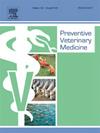让无形变得有形:利用发光物质提高禽舍前厅的意识和生物安全合规性的培训计划的效果
IF 2.2
2区 农林科学
Q1 VETERINARY SCIENCES
引用次数: 0
摘要
生物安全是限制传染性病原体在养禽场之间传播的预防策略的基石。然而,在进出禽舍时经常会发现对生物安全措施遵守不力的情况。与前厅相关的生物安全错误(即不遵守前厅分区,不换鞋、不穿衣、不洗手)通常被描述为缺乏知识、理解、风险意识或技术技能。在这项研究中,我们设计并评估了一项干预措施的效果,该措施旨在利用在紫外线下发光的物质来模拟微生物污染,从而提高前厅生物安全合规性。145 名对动物饲养感兴趣的参与者(兽医专业学生、农学专业学生、家禽饲养员和家禽饲养场顾问)参加了单节课的培训练习。通过测量参与者对特定生物安全措施的态度和意向的变化来评估练习的效果。学员的态度和意向在培训前后通过问卷进行了量化。得分变化通过多元线性回归模型进行评估,以衡量各种参数对这一变化的影响。参与者的态度和意向在统计学上有所改善(p <0.05),并受到初始态度和意向得分、参与者性别和参与者身份(学生类型或在家禽业的活动)的影响。该练习材料被认为具有趣味性和吸引力,可将其纳入家禽业所有利益相关者的生物安全培训框架。本文章由计算机程序翻译,如有差异,请以英文原文为准。
Making the invisible visible: Effectiveness of a training program to increase awareness and biosecurity compliance in poultry barn anterooms, using glowing substances
Biosecurity is the cornerstone of prevention strategies to limit infectious pathogen spread between poultry farms. However, poor compliance of biosecurity measures is often observed when entering or exiting barns. The lack of knowledge, understanding, risk perception or technical skill are often described for anteroom-related biosecurity errors (i.e., not respecting anteroom zoning in relation to changing boots, clothing, and hand sanitation). In this study, we designed and assessed the efficacy of an intervention aiming at improving biosecurity compliance in anterooms, using substances glowing under ultraviolet light, which mimic microbiological contamination. Training exercises offered in a single session were proposed to 145 participants with an interest in animal farming (veterinary students, agricultural students, poultry farmers and poultry farm advisors). The exercises’ efficacy was assessed by measuring the change in attitude and intentions of participants about specific biosecurity measures. The participants’ attitudes and intentions were quantified using a questionnaire before and after training. The change in score was assessed in a multivariate linear regression model to measure the effect of various parameters on this change. The attitudes and intentions of participants were statistically improved (p < 0.05) and were affected by the initial attitude and intention score, the gender of the participants and the status of the participant (type of student or activity in the poultry industry). The use of this exercise material, perceived as playful and engaging, could be included in the framework of biosecurity training for all stakeholders of the poultry industry.
求助全文
通过发布文献求助,成功后即可免费获取论文全文。
去求助
来源期刊

Preventive veterinary medicine
农林科学-兽医学
CiteScore
5.60
自引率
7.70%
发文量
184
审稿时长
3 months
期刊介绍:
Preventive Veterinary Medicine is one of the leading international resources for scientific reports on animal health programs and preventive veterinary medicine. The journal follows the guidelines for standardizing and strengthening the reporting of biomedical research which are available from the CONSORT, MOOSE, PRISMA, REFLECT, STARD, and STROBE statements. The journal focuses on:
Epidemiology of health events relevant to domestic and wild animals;
Economic impacts of epidemic and endemic animal and zoonotic diseases;
Latest methods and approaches in veterinary epidemiology;
Disease and infection control or eradication measures;
The "One Health" concept and the relationships between veterinary medicine, human health, animal-production systems, and the environment;
Development of new techniques in surveillance systems and diagnosis;
Evaluation and control of diseases in animal populations.
 求助内容:
求助内容: 应助结果提醒方式:
应助结果提醒方式:


